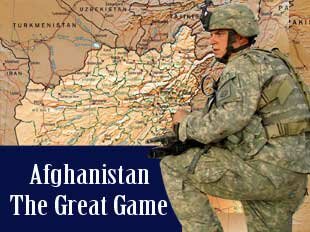A glance at a map and a little knowledge of the region suggest that the real reasons for Western military involvement may be largely hidden.
Afghanistan is adjacent to Middle Eastern countries that are rich in oil and natural gas. And though Afghanistan may have little petroleum itself, it borders both Iran and Turkmenistan, countries with the second and third largest natural gas reserves in the world. (Russia is first.)
Turkmenistan is the country nobody talks about. Its huge reserves of natural gas can only get to market through pipelines. Until 1991, it was part of the Soviet Union and its gas flowed only north through Soviet pipelines. Now the Russians plan a new pipeline north. The Chinese are building a new pipeline east. The U.S. is pushing for "multiple oil and gas export routes." High-level Russian, Chinese and American delegations visit Turkmenistan frequently to discuss energy. The U.S. even has a special envoy for Eurasian energy diplomacy.
Rivalry for pipeline routes and energy resources reflects competition for power and control in the region. Pipelines are important today in the same way that railway building was important in the 19th century. They connect trading partners and influence the regional balance of power. Afghanistan is a strategic piece of real estate in the geopolitical struggle for power and dominance in the region.
Since the 1990s, Washington has promoted a natural gas pipeline south through Afghanistan. The route would pass through Kandahar province. In 2007, Richard Boucher, U.S. assistant secretary of state, said: "One of our goals is to stabilize Afghanistan," and to link South and Central Asia "so that energy can flow to the south." Oil and gas have motivated U.S. involvement in the Middle East for decades. Unwittingly or willingly, Canadian forces are supporting American goals.
The proposed pipeline is called TAPI, after the initials of the four participating countries (Turkmenistan, Afghanistan, Pakistan and India). Eleven high-level planning meetings have been held during the past seven years, with Asian Development Bank sponsorship and multilateral support (including Canada's). Construction is planned to start next year.
The pipeline project was documented at three donor conferences on Afghanistan in the past three years and is referenced in the 2008 Afghan Development Plan. Canada was represented at these conferences at the ministerial level. Thus, our leaders must know. Yet they avoid discussion of the planned pipeline through Afghanistan.
The 2008 Manley Report, a foundation for extending the Canadian mission to 2011, ignored energy issues. It talked about Afghanistan as if it were an island, albeit with a porous Pakistani border. Prime Minister Stephen Harper says he "will withdraw the bulk of the military forces" in 2011. The remaining troops will focus mostly on "reconstruction and development." Does that include the pipeline?
Pipeline rivalry is slightly more visible in Europe. Ukraine is the main gateway for gas from Russia to Europe. The United States has pushed for alternate pipelines and encouraged European countries to diversify their sources of supply. Recently built pipelines for oil and gas originate in Azerbaijan and extend through Georgia to Turkey. They are the jewels in the crown of U.S. strategy to bypass Russia and Iran.
The rivalry continues with plans for new gas pipelines to Europe from Russia and the Caspian region. The Russians plan South Stream - a pipeline under the Black Sea to Bulgaria. The European Union and U.S. are backing a pipeline called Nabucco that would supply gas to Europe via Turkey. Nabucco would get some gas from Azerbaijan, but that country doesn't have enough. Additional supply could come from Turkmenistan, but Russia is blocking a link across the Caspian Sea. Iran offers another source, but the U.S. is blocking the use of Iranian gas.
Meanwhile, Iran is planning a pipeline to deliver gas east to Pakistan and India. Pakistan has agreed in principle, but India has yet to do so. It's an alternative to the long-planned, U.S.-supported pipeline from Turkmenistan through Afghanistan to Pakistan and India.
A very big game is underway, with geopolitics intruding everywhere. U.S. journalist Steven LeVine describes American policy in the region as "pipeline-driven." Other countries are pushing for pipeline routes, too. The energy game remains largely hidden; the focus is on humanitarian, development and national security concerns. In Canada, Afghanistan has been avoided in the past two elections.
With the U.S. surge underway and the British ambassador to Washington predicting a decades-long commitment, it's reasonable to ask: Why are the U.S. and NATO in Afghanistan? Could the motivation be power, a permanent military bridgehead, access to energy resources?
Militarizing energy has a high price in dollars, lives and morality. There are long-term consequences for everyone. Canadian voters want to know: Why is Afghanistan so important?
Source: John Foster (Toronto Star)
August 14, 2009



